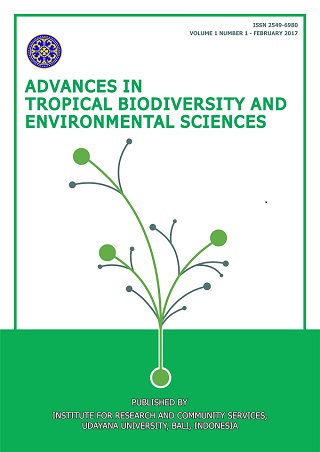The Potency of Endofit Fungi in Cocoa as Biological Agent to Control Cocoa Pod Disease Caused by Phytophthota Palmivora (Butler) Butler
Abstract
Cocoa pod disease caused by the fungus Phytophthora palmivora has resulted in loss of cacao in Indonesia, especially in Bali. So far the disease control strategy is not fully understood. So there is a need to find an alternative by using endophytic fungi associated with cocoa plant. Endophytic fungi are needed to be explored in all parts of the cocoa plant such as stems, leaves and husks. The prevalence of fungal endophyte was determined by the size of its domination on the surface tissue for protection against pathogen. The exploration of the endophytic fungi benefits is aimed at finding biological agent s that could control of pathogenic P. palmivora. The results showed that 15 types of endophyte fungi have been found in the healthy leaves, stem and pod husks, with the prevalence of fungal endophyte originated from healthy leaf Mecelia sterilia (hyphae sterile) around 30%, the endophyte fungi originated from the healthy cocoa stem are Mycelia sterilia, Neurospora spp and Trichoderma spp around 25%. While the endophytic fungi originated from healthy skin fruit is Trichoderma spp. around 35%. The in vitro test results of endophytic fungi antagonistic against P. palmivora indicated that the endophyte fungi originated from the leaf namely Aspergillus spp was obtained at 80 ± 2%, A. niger 90 ± 2%, A. flavus 100%, and Trichoderma spp. 90 ± 1.5%, the endophytic fungus originated from rods namely Neurospora spp. was 95 ± 2%, and Trichoderma spp. was 90 ± 2%. While the endophytic originated from rind namely Neurospora spp . was 95 ± 1.5 % and Trichoderma spp. was 80 ± 2%. The results of in vivo test of antagonistic endophytic fungi against P. palmivora showed that all of endophytic fungi (Aspergillus sp., A. niger, A. flavus, Neurospora sp., and Trichoderma sp.) have a significant effect in suppressing the growth of mycelium P. palmivora.
Keywords: Endophytic Fungus, Phytophthora Palmivora, Inhibition, Prevalence, Biological Agents













